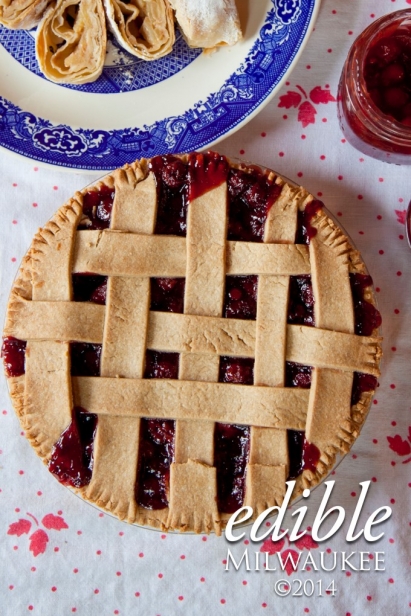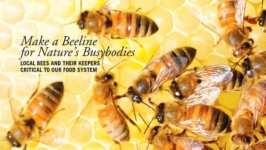What is This Pie?
The agony and the ecstasy of an American classic
Marlys Pavlicsek grew up in Germany. Orphaned shortly after World War II, she was taken in by a family who had returned to Germany after living in the U.S. Mrs. Pavlicsek trained as a household cook, including making the classic German pastry: strüdel. At that time, every hausfrau worth her salt could make a strüdel from scratch.
But she also fondly remembers the first time she tasted American-style Apple Pie as made by her foster mother. She told me, “I opened my eyes wide and asked her, ‘What is this Pie?'”
When I met Marlys recently, her innocent, childhood question became my inspiration. What is this pie? Homey, delicious and versatile, it has become both a source of pride and torment to home bakers. We’re teased with pictures of luscious fruits encased in a perfectly flaky crust. But when we attempt to take our garden bounty and make that most American of pastry: failure. Soggy crusts, runny middles, burnt edges, mushy or under-cooked fruits, unset custards and flat meringues. Sigh. All these familiar disasters have made many swear off pie-making forever.
All is not lost! The key to successful pie making is understanding our pie forefathers and the individual elements that combine to create heavenly pie.
American pie has distinct French and German roots. It’s easy to see modern pie in a French tart. As well as see the familiar sweetened fruit filling of the German strüdel. What makes our pastry so very American is the crust. Both tarts and strüdels use a crust that, though similar in ingredients, differs from American crust in the preparation. It’s all about the gluten.
That much maligned protein present in flour, gluten is the main ingredient in pie crust. Gluten is stretched by kneading and rolling, giving the dough an elasticity. That stretchiness is what makes strüdel light and crunchy. It’s what makes tarts hold firm their custard and fruit fillings. For American pie, the dough is worked as little as possible, leaving the gluten strands very short. This method lets the fat in the dough release moisture and create flaky layers.
That being said, there are subtle and tasty varieties of pie crusts. The most basic pie dough crust is comprised of a flour, sugar, salt, and a fat. Different flours impart varying flavors and consistencies to doughs: whole wheat gives a nutty taste, while rye flour makes for a heavy sour-ish dough that matches well with blueberries.
The crux of the crust comes in the varieties of fats that can be used. Many bakers swear by lard. This rendered fat works well, as it has a low melting point and high liquid content – exactly what’s needed for that perfect pie crust. The knock against lard is that some tasters will detect a slight ‘bacony’ taste. (Which in my mind is not a bad thing…) Lard also renders your pie off-limits to vegetarians.
As educated eaters, we’ve learned that hydrogenated vegetable oils (Crisco and his crew) are not healthy. Personally, I like to use foods that have been processed as little as possible and are as close to their natural state. I’m a fan of butter. Pie crusts made with butter have the flaky, tender, mouth-feel we’re looking for.
A type of pie crust often matched with cream and custard-based pies is the ‘crumb crust.’ These are often thought of as a very American shortcut, but in reality it has its roots in German baking. Crumb crusts are at their most basic a cookie or cracker that is pulverized, sweetened and made into a dough by adding melted butter. Graham crackers, shortbread, ginger snaps, whatever you can think of – all can be crunched up and reconstituted into a pie crust. German baking has a long tradition of making pastry fillings and cakes with the dried crumb of other cakes. Baked goods of any kind are never to be wasted, so yesterday’s stale cake is tomorrow’s crust.
A final word on pie crusts. Rolling. It’s not as hard as you think. Forget the mess, here’s the easy way to roll out your pie dough. Lay down a sheet of parchment paper. Put your dough in the middle of the parchment, lay another sheet on top. Now roll. When you want to ‘turn over’ the dough to even out the height, turn over the whole parchment and dough sandwich. You can flip back and forth with ease and without the floury mess. When your crust is to your desired thickness, just peel off the top layer. Place your pie plate under the exposed crust, fit it in the plate. Then peel back the remaining layer of parchment. Voila! Easy and not a single tear in the crust.
Once you’ve got your crust, you need to fill it. American pies fall squarely into two styles: Fruit and Cream/Custard pies. Both fillings present their own challenges. But challenges are easy when you know what to do.
The death knell of the fruit pie is the runny filling. A perfect crust can only contain the fruit; once cut…well, you know, it ends in tears. We need to change our thinking about pie filling. It’s more than just sweetened fruit.
All fruit contains water, and that liquid is released when the fruit is heated. So if you put raw fruit sprinkled with sugar and flour into a pie shell, top it with a crust, then bake, you are guaranteed a sad, runny pie 99% of the time. If we release and absorb the moisture in the fruit, we solve the problem.
Heat is our friend here. If using fresh fruit, we need to cook it over low heat for a very short time – just long enough for it to release its juice. Then separate the fruit from the juice. (Here’s where the frozen/canned fruit join in the process.) Using the juice as base, add sweetener, choice of spices and our thickening paste. The heat acts as catalyst and thickens the juice blend. In many kitchens, you’ll hear this referred to as “slurry."
Sarah Jonas and Cameryne Roberts, owners of Cafe Lulu and Juniper 61, have made 19,500 pies since opening Lulu in 2001. In the early days of the restaurant, they took turns making the pies. Sarah made a thinner slurry, Cameryne a thicker. Many mornings were spent arguing about who was more right. What they discovered was that there really was no ‘right’ way. Personal preference should be the guide as to how thick your slurry should be.
Cafe Lulu pies have a medium-thick filling that stands up nicely to vanilla ice cream. I recommend making a nice thick slurry, then add your fruit back in. A thicker slurry will thin out in the baking process as your fruit releases even more juice. Fold the entire contents into your pie plate. The extra step of preparing a thickened slurry guarantees your pie filling will be glossy and thick when served.
Besides cornstarch, other thickeners found in pies are tapioca, flour, breadcrumbs and clear jel. (Clear Jel is a modified cornstarch and is the only thickener scientifically proven safe for canning.) Canning your own pie filling is another step to perfecting pie; you will have your favorite fruit ready-to-go in a jar knowing that it’s preservative-free and made from your ingredients to your tastes.
Custard pies and cream pies are closely related cousins. Custards are, of course, a cream and egg mixture. While cream-based pies have dairy as their main element, they are also known as refrigerator pies because they require no baking, only chilling, to set the cream. Custard pies need the added element of heat to thicken and bring the mixture together before baking. Any pie filling that requires eggs and milk, even if it has additional fruit/vegetables, is still a custard pie.
Many recipes for pumpkin and sweet potato style pies call for a basic mixing of the ingredients and pouring it into a par-baked pie shell. But cooking the custard mixture before pouring into the shell will result in a smoother consistency without the dreaded cracks along the surface.
Pies are a delicate balance of crust, filling, patience and practice. The simple ingredients bely the skills needed to execute a well-made pie. Which is why beautiful pies are so lavishly praised. Give yourself permission to focus first on creating a pie that tastes great, then work to improve the presentation.
There has not been a single person in all of human history who ever said ‘no’ to a messy slice of pie! After a few experiments, your techniques will become second nature. And maybe you’ll have the chance to see the amazement in a young child’s eyes as they say: “What is this pie?”







